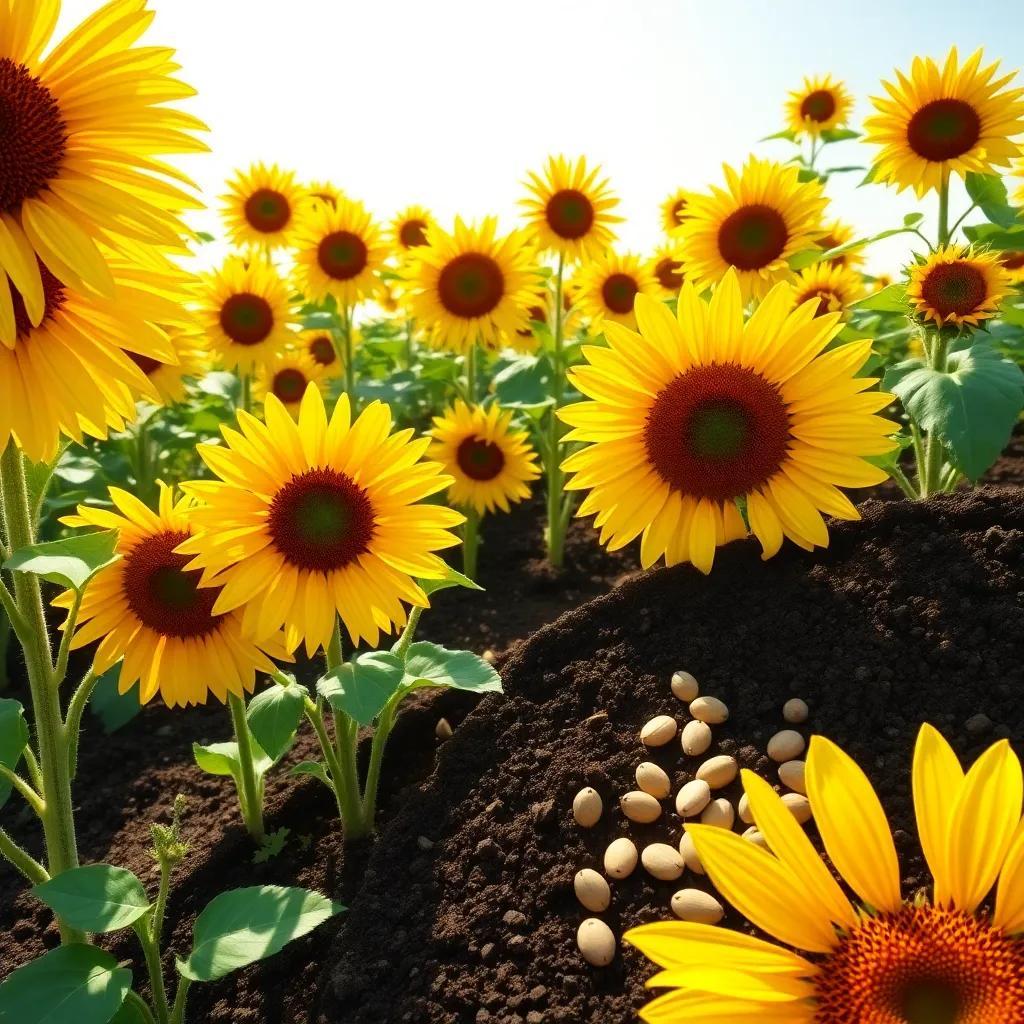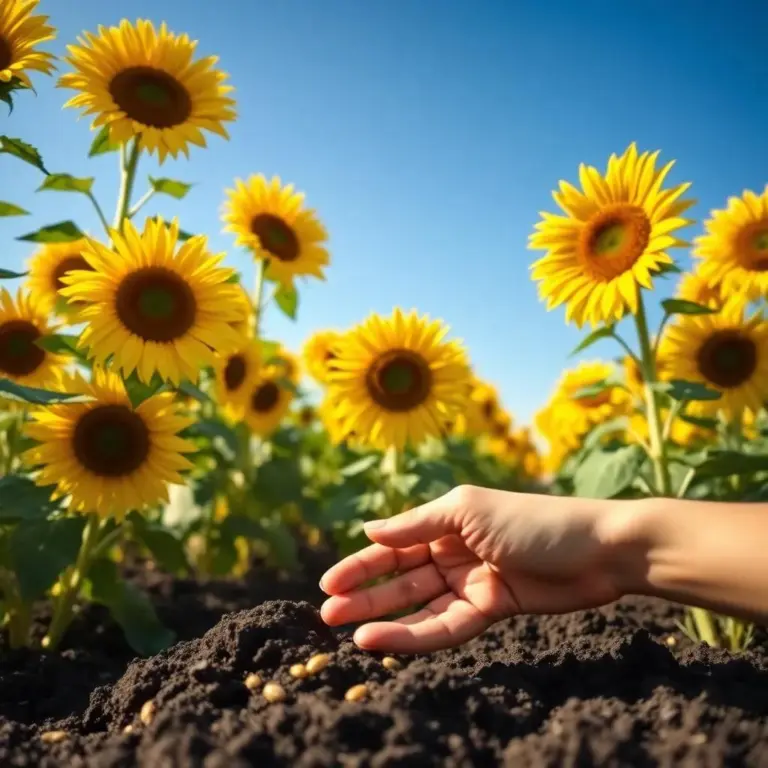Have you ever wanted to grow your own sunflowers and watch them reach for the sky? These cheerful flowers not only brighten up any garden, but they also bring joy and a sense of accomplishment! Join me as we explore the journey of growing sunflowers from seed to bloom, and discover the secrets to making your garden the brightest on the block! 🌻✨
Factors Influencing Sunflower Growth Rates
When it comes to growing sunflowers, several factors can play a big role in how quickly and beautifully they bloom! I mean, who doesn’t want to see those huge yellow flowers swaying in the breeze? Let’s break down the key things that can affect our sunflower growing adventure!
- Temperature: Sunflowers are warm-weather lovers! They thrive in temperatures between 70°F and 78°F (21°C and 26°C). If it’s too cold, those little seeds might just sit there and think about going to sleep instead of sprouting. On the flip side, too much heat can stress them out, making it tough for them to grow strong. It’s like finding the perfect cozy blanket on a chilly day—just right!
- Light: Sunflowers are sun worshippers! They require at least 6 to 8 hours of direct sunlight per day. If they don’t get enough sunshine, they might become weak and want to stretch out in search of light. I always try to plant mine in a spot that gets plenty of sun; those happy sunflowers always make me smile!
- Soil Quality: Good soil is where the magic begins! Sunflowers love well-drained, rich soil. Before planting, I make sure to loosen the soil and even mix in some organic matter. This way, the seeds have a nurturing environment to dig into.
- Watering: Even though sunflowers can handle some dryness, they appreciate a consistent watering schedule. Just keep the soil moist! During the germination stage, I check the soil moisture regularly. Nobody likes soggy roots, right?
- Competition: Finally, make sure those sunflowers have their own space! Weeds and other plants can steal nutrients and water. Keeping a weed-free zone helps sunflowers thrive.
By paying attention to these factors, you’ll help your sunflowers grow strong and beautiful, making your garden the talk of the neighborhood!
Understanding the Germination Process of Sunflower Seeds
Let’s get to the exciting part—germination! This is when those little sunflower seeds start waking up from their long sleep, ready to grow into those magnificent blooms we all adore! Typically, sunflower seeds take about 7 to 10 days to germinate. Here’s how I like to make sure my seeds have the best chance of sprouting:
- Choose Quality Seeds: I always go for the best seeds! Look for seeds that are plump and undamaged. They need to be healthy to sprout properly!
- Prepare the Soil: Before planting, I loosen the soil and remove any weeds. Sunflowers like their soil well-drained and rich in nutrients. Adding some compost can give those seeds a great start!
- Planting Depth: I plant the seeds about 1 to 2 inches deep. It’s like tucking them in for a cozy sleep! I also make sure to space them at least 6 to 12 inches apart, depending on the variety. This helps them grow without feeling cramped.
- Watering: After planting, I give the soil a gentle drink. The goal is to keep it moist but not soggy! Too much water can drown the seeds—yikes!
- Keep it Warm: Sunflower seeds love warmth! If it’s chilly outside, I sometimes use plastic covers to keep them cozy. They like to germinate best in temperatures between 70°F and 78°F (21°C and 26°C).
With these steps, I’ve seen many tiny green shoots popping up, and it always fills my heart with joy! Watching those seedlings grow is just the beginning of an exciting sunflower journey! 🌻🌞

Caring for Sunflower Seedlings: Essential Tips
So, your sunflower seeds have sprouted, and now it’s time to care for those adorable little seedlings! This part is super exciting because it’s where your hard work starts to pay off. Helping your seedlings thrive is essential for a healthy sunflower garden! Here are some tips to keep those young plants happy and growing strong:
- Light, Light, Light: Sunflower seedlings need plenty of sunshine to grow big and strong. Aim for at least 6 to 8 hours of direct sunlight every day. If you’re growing them indoors or in a shady spot, consider using grow lights to give them that sun-kissed glow.
- Watering: Keeping the soil consistently moist is key. I like to water deeply about once or twice a week. Make sure not to drown them, though! Too much water can lead to soggy roots, which isn’t a fun way for plants to grow. Always check the moisture level before watering!
- Thinning: If you planted multiple seeds together, it’s time to give those seedlings some breathing room! Once they’ve developed their first true leaves, carefully remove the weaker ones. This allows the stronger seedlings to soak up more nutrients and space to grow.
- Fertilization: At this stage, seedlings don’t need heavy feeding. A diluted balanced fertilizer will do the trick! Just follow the instructions on the package. Too much fertilizer can lead to lots of leaves but few flowers, and that’s not what we want!
- Protection: Keep an eye out for pesky pests! A lightweight row cover can protect your seedlings from insects and birds. If it gets windy, staking your seedlings can help keep them upright.
By following these tips, you’ll be well on your way to nurturing healthy sunflowers that will shine brightly in your garden! 🌻
The Vegetative Stage: Growth of Sunflower Foliage
Now that our sunflower seedlings are thriving, they’re entering the vegetative stage, where they focus on growing those big, luscious leaves and developing a strong root system! This phase is vital because it sets the groundwork for those gorgeous blooms we anticipate. Here’s what I do to support my sunflowers during this exciting time:
- Watering Wisely: Sunflowers need regular watering, especially during the vegetative stage. I water them deeply about once or twice a week, making sure the soil stays moist but not waterlogged. Overwatering can lead to root problems, so be cautious!
- Soil Fertility: Healthy soil means happy sunflowers! If your soil isn’t very rich, consider adding compost or organic fertilizers high in nitrogen. Nitrogen is like a growth booster for those green leaves, helping them flourish.
- Weed Control: Weeds can be sneaky little thieves, stealing nutrients and water from your sunflowers. I check my garden regularly for weeds and remove them to help my sunflowers thrive. A layer of mulch can also help keep those pesky weeds at bay!
- Support for Tall Varieties: If you chose a towering sunflower variety, it might need some extra support! I like to stake my plants to prevent them from bending over in strong winds. Trust me, it can make a huge difference!
- Pruning: Although sunflowers don’t need a ton of pruning, it’s a good idea to remove any damaged or diseased leaves. This helps promote healthy air circulation and keeps your plants happy.
During this vegetative stage, I love watching my sunflowers grow taller and taller! Before I know it, they’ll be ready for the flowering stage, and I can’t wait to see those bright blooms!
Harvesting Sunflowers: Timing and Techniques
Ah, the moment we’ve all been waiting for—harvesting sunflowers! This stage is exciting because it shows off all the hard work you’ve put into growing these beautiful plants. Whether you’re after their stunning blooms or nutritious seeds, it’s important to know when and how to harvest. Here are my favorite tips for a successful sunflower harvest:
- Timing is Everything:
– If you’re growing sunflowers for their gorgeous flowers, you can start harvesting as soon as they’ve reached their full color and the petals are wide open.
– For seeds, wait until the backs of the sunflower heads turn brown. The seeds should feel firm and dry. This is the sign that they’re ready to be collected!
- Cutting Flowers: To save your lovely blooms, cut the flower stalks early in the morning or late in the evening when the flowers are hydrated. Use sharp gardening shears and make a clean cut near the base of the stalk. With proper care, these flowers can last for several days in a vase!
- Collecting Seeds:
– For seed harvesting, first, cut the heads off the stalks, leaving a few inches of stem attached.
– Hang the sunflower heads upside down in a cool, well-ventilated area to dry completely. Once they’re dry, gently rub the heads to release the seeds.
- Storing Seeds: After harvesting, store your seeds in an airtight container or bag in a cool, dry place. This keeps them fresh for planting or feeding birds during the winter!
- Enjoying the Blooms: Don’t forget to take a moment to admire your beautiful sunflowers before cutting them! Snap some photos or even create a mini bouquet to brighten your home.
Harvesting sunflowers is the rewarding finale to your gardening adventure! Whether you’re enjoying their beauty or collecting seeds, it’s a joyful experience that makes all the effort worthwhile. 🌻✨

